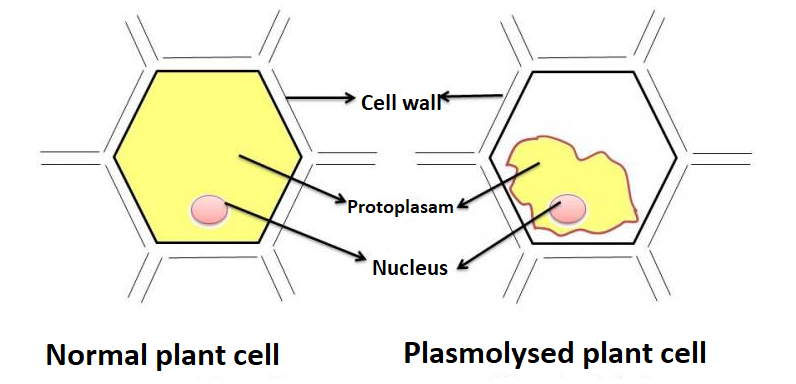
What is plasmolysis? Draw neat labelled diagrams of normal cells and plasmolysed cells.
Answer
402.6k+ views
Hint: There are some mechanisms in plants to avoid excess water loss in the same way as excess water gain. Due to plasmolysis, the protoplasm reduces in size. It is an example of the results of osmosis. Through observation of plasmolysis and deplasmolysis, it is possible to determine the tonicity of the cell as well as the rate the solutes cross the cellular membrane.
Complete answer:
The net water/ solvent movement across a membrane toward a higher solute concentration is called as osmosis. If two solutions have unequal concentrations, the solution with higher solute concentration is hypertonic and the solution with lower solute concentration is hypotonic. If the solute concentration of the two solutions are equal, the solutions are isotonic.
If red blood cells are placed in a solution with higher solute concentration in the solution than the solute concentration in the cytoplasm of the cells, water diffuses out of the cells causing them to shrivel up. If red blood cells are placed in a hypotonic solution, where the solute concentration of the solution is less than the solute concentration in the cytoplasm, water diffuses into the cells, the cells swell up and eventually burst. In contrast, plant cells are surrounded by strong cell walls which can withstand high internal pressures without bursting. When placed in a hypertonic solution, the cell membrane shrinks within the cell, but the cell wall remains intact. This is called plasmolysis. In a hypotonic solution, cells surrounded by the cell wall swell but do not burst because the cell wall is strong enough to withstand the turgor pressure.

Note:
Plasmolysis takes place in the extreme loss of water from the cell, and this makes it rare to occur and doesn’t happen very often in nature. Plasmolysis more commonly takes place in a laboratory setting. However, it can take place in real life too. Plasmolysis can be seen in plants which are exposed to chemical weedicides or coastal flooding. The reverse of plasmolysis is referred to as deplasmolysis.
Complete answer:
The net water/ solvent movement across a membrane toward a higher solute concentration is called as osmosis. If two solutions have unequal concentrations, the solution with higher solute concentration is hypertonic and the solution with lower solute concentration is hypotonic. If the solute concentration of the two solutions are equal, the solutions are isotonic.
If red blood cells are placed in a solution with higher solute concentration in the solution than the solute concentration in the cytoplasm of the cells, water diffuses out of the cells causing them to shrivel up. If red blood cells are placed in a hypotonic solution, where the solute concentration of the solution is less than the solute concentration in the cytoplasm, water diffuses into the cells, the cells swell up and eventually burst. In contrast, plant cells are surrounded by strong cell walls which can withstand high internal pressures without bursting. When placed in a hypertonic solution, the cell membrane shrinks within the cell, but the cell wall remains intact. This is called plasmolysis. In a hypotonic solution, cells surrounded by the cell wall swell but do not burst because the cell wall is strong enough to withstand the turgor pressure.

Note:
Plasmolysis takes place in the extreme loss of water from the cell, and this makes it rare to occur and doesn’t happen very often in nature. Plasmolysis more commonly takes place in a laboratory setting. However, it can take place in real life too. Plasmolysis can be seen in plants which are exposed to chemical weedicides or coastal flooding. The reverse of plasmolysis is referred to as deplasmolysis.
Recently Updated Pages
Master Class 10 Science: Engaging Questions & Answers for Success

Master Class 10 Social Science: Engaging Questions & Answers for Success

Master Class 10 Maths: Engaging Questions & Answers for Success

Master Class 10 English: Engaging Questions & Answers for Success

Class 10 Question and Answer - Your Ultimate Solutions Guide

Master Class 9 General Knowledge: Engaging Questions & Answers for Success

Trending doubts
State and prove Bernoullis theorem class 11 physics CBSE

1 ton equals to A 100 kg B 1000 kg C 10 kg D 10000 class 11 physics CBSE

State the laws of reflection of light

One Metric ton is equal to kg A 10000 B 1000 C 100 class 11 physics CBSE

Difference Between Prokaryotic Cells and Eukaryotic Cells

1 Quintal is equal to a 110 kg b 10 kg c 100kg d 1000 class 11 physics CBSE




